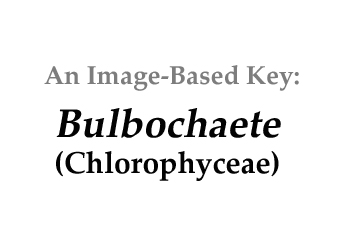|
Home / Greens / Filamentous / Branched / Bulbochaete
|
|
|
 
|
|
|

|

|

|

|

|
|
|

|
|
|
|
|
|
|
|
|
|
Click
on images for larger format
|
Name derivation:
|
|
Classification:
|
|
Bulbochaete C.Agardh 1817:
xxxix, 71; 110 of 155 species
descriptions are currently accepted taxonomically (Guiry
and Guiry 2014).
Order:
Oedogoniales;
Family: Oedogoniaceae
|
Morphology:
|
|
Often
epiphytic and attached to other vegetation, uniseriate
filaments, unilaterally branched, green algae. Vegetative cells have one nucleus
with many vacuoles and large reticulate parietal chloroplast containing one to many pyrenoids. There are
three morphologies for vegetative filaments: basal holdfast cells,
cylindrical intercalary cells, small terminal “hair” cells.
|
Similar
genera:
|
|
|
Commercial value:
|
|
Bulbochaete has been, along
with several other species of cyanobacteria and chlorophyceae,
genetically modified to produce more carbon for carbon based products of
interest. Ethanol or linolool are two products which can be produced with
these genetically modified cyanobacteria.
Modifying the gene that controls the MEP pathway as well as increasing
photosynthesis is a way to extract carbon from these species (Zhou &
Gibbons, 2012).
|
Cells
devoid of plastids:
|
|
Bulbochaete is a unique algal genus
where only few species have specialized cells that are devoid of
plastids. These cells are not involved
in reproduction. The study suggests that
the plastid containing organisms have a phagocytosis
stage during which they can engulf bacterial cells. This suggest how
photosynthetic eukaryotes evolved (Maruyama & Kim, 2013).
|
Habitat:
|
|
Bulbochaete occurs in a wide variety of freshwater habitats;
only a few species are known from brackish waters. Normally epiphytic and
attached to aquatic vegetation by basal holdfast cell; occasionally
free-floating. Most frequently encountered in small bodies of shallow,
standing water such as ponds, small lakes, and ditches. Cosmopolitan with
greatest abundance of species in temperate and subtropical regions (Guiry and Guiry 2014).
Bulbochaete
was reported from Lake Syczynskie in
Poland (Tarkowska-Kukuryk, 2013).
|
|
|
Citing Phycokey:
|
|
Baker,
A.L. et al. . Phycokey
-- an image based key to Algae (PS Protista),
Cyanobacteria, and other aquatic objects. University of New Hampshire Center
for Freshwater Biology. http://cfb.unh.edu/phycokey/phycokey.htm
|
|
References:
|
|
Agardh, C.A. 1817.
Synopsis algarum Scandinaviae, adjecta dispositione universali algarum. pp. [i]-xl,
[1]-135. Lundae [Lund]: Ex officina Berlingiana.
Guiry, M.D. and G.M. Guiry 2014. AlgaeBase.
World-wide electronic publication, National University of Ireland, Galway.
http://www.algaebase.org; searched on 19 December 2012.
Maruyama, S. and
K. Eunsoo. 2013. A Modern Descendant of Early Green Algal Phagotrophs.
Current Biology. V23;12. 1081-1084.
Tarkowska-Kukuryk, M.. 2013. Periphytic Algae
as Food Source for Grazing Chironomids in a Shallow
Phytoplankton-Dominated Lake. Limnologica- Ecology
and Management of Inland Waters. V43;4. 254-264.
Zhou, R. and W.
Gibbons 2012.
Genetically Engineered Cyanobacteria. US 20120276637 A1.
|





